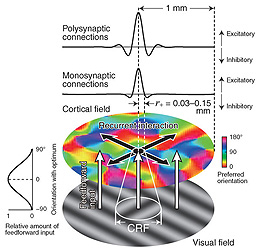Research Abstract
文脈依存的反応調節は方位選択性地図のピンウィール中心からの距離によって変わると予測される
Predicted contextual modulation varies with distance from pinwheel centers in the orientation preference map
2011年10月12日 Scientific Reports 1 : 114 doi: 10.1038/srep00114

ある種の哺乳類の第一次視覚野(V1)では、方位円柱の
- 九州大学大学院医学研究院
- 大阪大学大学院生命機能研究科 / 科学技術振興機構
- 東京大学大学院工学系研究科
- 東京大学生産技術研究所
In the primary visual cortex (V1) of some mammals, columns of neurons with the full range of orientation preferences converge at the center of a pinwheel-like arrangement, the ‘pinwheel center’ (PWC). Because a neuron receives abundant inputs from nearby neurons, the neuron’s position on the cortical map likely has a significant impact on its responses to the layout of orientations inside and outside its classical receptive field (CRF). To understand the positional specificity of responses, we constructed a computational model based on orientation preference maps in monkey V1 and hypothetical neuronal connections. The model simulations showed that neurons near PWCs displayed weaker but detectable orientation selectivity within their CRFs, and strongly reduced contextual modulation from extra-CRF stimuli, than neurons distant from PWCs. We suggest that neurons near PWCs robustly extract local orientation within their CRF embedded in visual scenes, and that contextual information is processed in regions distant from PWCs.

